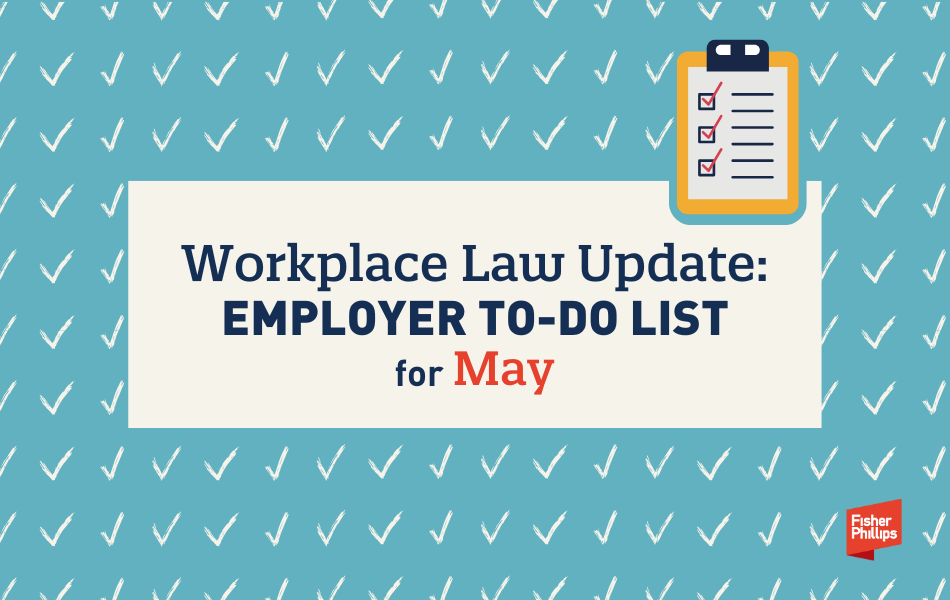Workplace Law Update: 10 Essential Items on Your May To-Do List
Insights
5.02.25
It’s hard to keep up with all the recent changes to labor and employment law, especially given the rapid pace at which the new administration has been moving on initiatives impacting the workplace and beyond. For the latest changes and a compliance action plan, here’s a quick review of some critical developments we tracked in April and a checklist of the essential items you should consider addressing in May and beyond.
|
_____ |
Check out our First 100 Days Report for employers. The first 100 days of any new administration set the tone for what’s to come — and in 2025, that tone has been unmistakable: bold, fast-moving, and deeply consequential for employers. That’s why we’ve created this special report —a snapshot of where things stand, where they’re headed, and what your organization should be doing to keep pace. |
|
_____ |
Stay tuned for more guidance on “disparate impact” claims. For decades, employers could face liability for policies and practices that didn’t intentionally discriminate but had a “disparate impact” on a group of job applicants or employees based on a protected characteristic, such as race or sex. The president is now aiming “to eliminate the use of disparate impact liability in all contexts to the maximum degree possible,” according to an April 23 executive order. Here’s what you need to know about this development and how it may impact your practices. |
|
_____ |
Review rollbacks on standards for federally funded EV and clean tech projects. The Trump administration also rescinded a key executive order that tied federal funding for clean energy and infrastructure projects to pro-union commitments – signaling a major shift for electric mobility companies and other federally funded employers. But lingering legal obligations remain for those already under contract. Click here to learn more about this development. |
|
_____ |
Prepare for EEO-1 reporting to begin. This year’s collection of EEO-1 reports could begin in less than a month – and will likely not allow employers to categorize workers as “non-binary.” Private employers with at least 100 employees and federal contractors with at least 50 employees should prepare to sort company data by employee job category, as well as by sex and race/ethnicity, to turn over to the EEOC between May 20 and June 24. While these dates are not yet set in stone, the compliance window will be here before you know it. Click here to learn more. |
|
_____ |
Safeguard your corporate leaders against rising security threats. Executives are increasingly at risk of becoming targets of violent acts or cyberattacks such as doxing or social engineering, and your organization must think ten steps ahead to ensure the safety of your people and the future of your business. Here’s an overview of executive protection programs and four key steps to help you build yours. |
|
_____ |
Consider alternatives to the H-1B visa for hiring foreign nationals. You may be disappointed if your candidate was not selected for an H-1B visa in the recent cap lottery – but not all hope is lost. If you employ foreign nationals, the good news is that you can explore certain short-term, long-term, and even some lesser-known solutions. Here are 11 alternatives your organization can use to retain top talent and critical staff, even if your candidate was not selected last month in the FY 2026 H-1B cap lottery. |
|
_____ |
Review your accommodation request process. A federal appeals court recently clarified that an employee may qualify for a reasonable accommodation under the Americans with Disabilities Act (ADA) even if they can perform essential job functions without such an accommodation. The 2nd Circuit’s March 25 decision in Tudor v. Whitehall Central School District reinforces that the ability to perform essential job functions is relevant – but not decisive – in ADA failure-to-accommodate claims. Here’s what employers need to know about this case. |
|
_____ |
Slay summer hiring. As the weather gets warmer and you shift your focus to seasonal hiring, you’ll want to be sure to connect with Gen Z applicants, many of whom are college and high school students in search of summer jobs. Here’s your guide to hiring Gen Z this summer. |
|
_____ |
Prepare for new state sick leave requirements in 2025. Over the past few years, we’ve seen a sharp increase in state-level legislation and ballot initiatives mandating employer-provided leave options for employees with strong voter support. Check out our compliance checklist for Missouri’s new paid sick leave law that took effect May 1, and learn more here about how your company can manage this patchwork of state laws. |
|
_____ |
Track additional state law developments. With so many changes at the federal level, don’t forget to stay updated on state and local developments, too. For example:
|
We will continue to monitor developments related to all aspects of workplace law. Make sure you are subscribed to Fisher Phillips’ Insight System to get the most up-to-date information. If you have questions, contact your Fisher Phillips attorney.
Related People
-
- Lisa Nagele-Piazza
- Lead Content Counsel
Service Focus
- Government Contracting, Compliance, and Reporting
- AI, Data, and Analytics
- Counseling and Advice
- Reputation and Crisis Management
- Employee Defection and Trade Secrets
- Employee Leaves and Accommodations
- Employment Discrimination and Harassment
- Government Relations
- Labor Relations
- Pay Equity and Transparency
- Privacy and Cyber
- Litigation and Trials
- Wage and Hour
- Workplace Safety and Catastrophe Management

